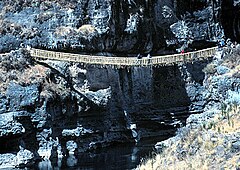Rope bridge
Appearance
This article needs additional citations for verification. (May 2014) |
 A rope bridge in South America | |
| Ancestor | None - this is a foundational type |
|---|---|
| Related | Inca rope bridge |
| Descendant | Simple suspension bridge |
| Carries | Pedestrians, livestock |
| Span range | short |
| Material | Grass or other rope, appropriate decking material |
| Movable | No |
| Design effort | low |
| Falsework required | No |
A rope bridge is a bridge constructed chiefly of rope. In its simplest form, it can be one or two ropes that bridge a river, enabling the traveller to be supported in their crossing and not be swept away. One rope above another, for feet and hands, may be referred to as a commando bridge.
More complicated rope bridges can involve the use of multiple ropes, and boards as footpaths. One of the most complex examples of a culture using these as permanent, rather than temporary crossings, is the Inca civilization.
An 1853 watercolor by Manuel María Paz shows two men crossing a rope bridge over the Igara Paraná River "made of wood and lianas".[1]
References
- ^ Paz, Manuel María. "Bridge on the Ingará River, Province of Chocó". World Digital Library. Retrieved 2014-05-22.
See also
Wikimedia Commons has media related to Rope bridges.
